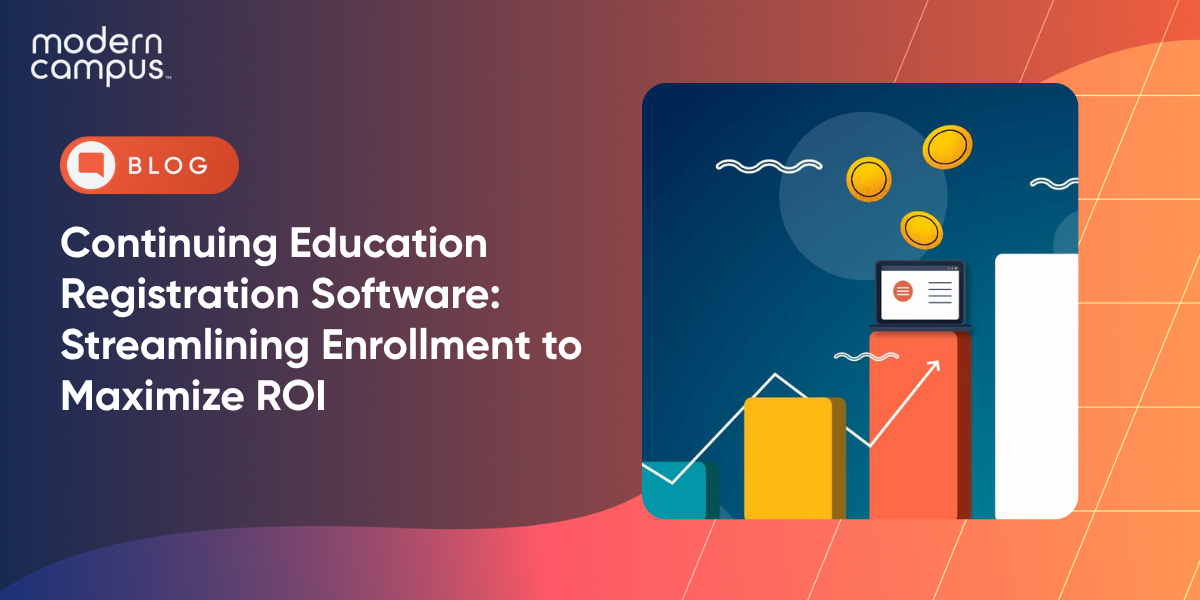Continuing Education Registration Software: Streamlining Enrollment to Maximize ROI
Continuing education is experiencing unprecedented growth, with the global market projected to reach $58 billion by 2030 at a 20% compound annual growth rate. Despite this expansion, many institutions struggle with outdated registration processes that create barriers for the very learners they're trying to serve.
The right continuing education registration software can transform not just administrative efficiency but the entire student experience. When adults prefer non-degree education options and expect seamless digital experiences, institutions can no longer afford registration systems that frustrate and deter potential learners.
Why Continuing Education Registration Software Matters
While undergraduate enrollment continues its slow upward trend, certificate and non-credit programs are seeing significant growth, with undergraduate certificate program enrollment increasing 4.8%. This surge reflects a shift in how adults approach education and skill development.
Non-traditional students differ demographically as well as behaviorally. They research, compare and make purchasing decisions like consumers because that's exactly what they are. They expect the same frictionless experiences they get from e-commerce, subscription-based entertainment services and other digital-first companies. When your registration process involves paper forms, phone calls and days of waiting for confirmation, you're actively driving away revenue.
According to the 2025 State of Continuing Education report, institutions are struggling with low enrollment rates even as market demand grows. The disconnect isn't about content quality or institutional reputation; it's about accessibility and user experience. Students want to register at 11 PM on a Sunday, receive instant confirmation and access their materials immediately. Continuing education registration software makes this possible.
Key Challenges in Traditional Registration Processes
Traditional registration systems create friction at every touchpoint, often turning enthusiastic prospective students into frustrated former prospects. Understanding these pain points is the first step toward creating better experiences.

Fragmented Information Systems
One of the primary challenges faced by individuals seeking continuing education is the lack of centralized information. Students often struggle to find comprehensive course catalogs, detailed schedules and clear admission requirements. This fragmented approach leads to confusion and discourages enrollment.
When course information lives in PDFs, scheduling details exist only in spreadsheets and payment options require phone calls, you've created an obstacle course instead of a pathway to learning. Research from digital transformation experts shows that higher education leaders cite digital transformation as one of their biggest challenges, largely because legacy systems can't meet modern student expectations.
Complex Multi-Step Forms
Lengthy and complex registration forms significantly discourage prospective students. When adults are juggling work, family and other commitments, asking them to complete 20-field forms with unclear requirements is a recipe for abandonment. The overwhelming nature of these forms, filled with unnecessary personal details and confusing academic history requirements, creates barriers that prevent registration completion.
Modern learners expect streamlined experiences. If they can book a vacation rental in three clicks, why should course registration take 30 minutes and multiple form submissions?
Limited Payment Flexibility
Higher education costs continue to rise, making payment flexibility crucial for accessibility. Traditional methods like checks or money orders aren't convenient for busy professionals who expect instant transactions and multiple payment options. When institutions don't offer credit cards, digital wallets or payment plans, they exclude entire demographics from their programs.
Manual Administrative Burden
Perhaps the biggest hidden cost of outdated registration systems is the staff time required to manage them. When registration involves manual data entry, phone calls for payment processing and constant back-and-forth communication to resolve issues, your team spends more time on administrative tasks than strategic initiatives that could grow your programs.
University of Toronto's Ontario Institute for Studies in Education solved this exact problem by implementing self-service systems that reduced manual workload while improving student satisfaction.
Essential Features of Modern Continuing Education Registration Software
The best continuing education management software combines automation, user experience and institutional efficiency into systems that benefit everyone involved.
Automated Enrollment and Payment Processing
Modern registration platforms automate the entire enrollment workflow, from initial course selection through final payment confirmation. Students can browse courses, check prerequisites, register instantly and receive immediate access to materials, all without staff intervention.
The automation extends beyond registration. Leading platforms handle payment processing, send confirmation emails, integrate with learning management systems and automatically manage waitlists. This level of automation creates the instant gratification that modern learners expect.
Mobile-Responsive Student Portals
With students increasingly accessing educational content on mobile devices, responsive design is essential. The best continuing education tracking software provides seamless experiences across devices, allowing students to register during lunch breaks, on commutes or whenever inspiration strikes.

Students can track their progress toward certificates, view transcripts, update personal information and access course materials, all from their smartphones.
Integration with SIS and ERP Systems
Successful continuing education registration software seamlessly integrates with existing Student Information Systems, Enterprise Resource Planning platforms and Learning Management Systems to create unified experiences for students and staff.
This integration eliminates data silos, reduces duplicate entry and ensures that continuing education students receive the same quality of service as traditional degree-seeking students. When systems talk to each other, students get consistent experiences and administrators get complete pictures of institutional performance.
Compliance and Certification Tracking
For many non-traditional student management systems, tracking certifications, professional development hours and compliance requirements is mandatory. The best platforms automate tracking, sending reminders for upcoming renewals and maintaining complete audit trails for regulatory compliance.
This feature is particularly crucial for professional development programs where students need documentation for licensing boards or employer requirements.
Strategies to Streamline Registration and Boost Enrollment
Implementation success depends on strategic thinking, not just technology deployment. The most effective institutions approach registration transformation under a holistic lens.
Centralized Registration Platforms
To address fragmented information challenges, institutions need centralized student registration platforms that provide comprehensive, user-friendly interfaces. Students should access complete course catalogs, view schedules and find admission information in one location.
Centralization benefits more than just students. Staff gain unified dashboards for monitoring enrollment trends, identifying popular programs and making data-driven decisions about future offerings.
Simplified User Experience Design
Simplifying registration forms improves user experience. Institutions should collect only essential information initially, using progressive profiling to gather additional details over time. Smart forms that remember user information, provide real-time validation and clearly explain requirements reduce friction and increase completion rates.
The best platforms also offer guest checkout options for free or low-cost courses, allowing prospective students to experience your institution before committing to lengthy registration processes.
Flexible Payment and Pricing Options
Modern continuing education registration software supports multiple payment methods, installment plans and corporate billing arrangements. Some platforms even integrate with employer tuition assistance programs, making it easier for companies to support employee development.
Early bird discounts, group pricing and loyalty programs can all be automated within these systems, encouraging early registration and repeat engagement without manual intervention.
Automated Communication Workflows
Effective communication keeps students engaged throughout their educational journey. Modern platforms send automated confirmations, course reminders, assignment notifications and completion certificates. They can also handle more complex scenarios like abandoned cart recovery, where students who start but don't complete registration receive targeted follow-up communications.
The best continuing education student management systems can nurture prospective students with relevant course recommendations, program updates and educational content that builds relationships over time.
Top 10 Must-Have Registration Software Features
When evaluating continuing education registration software options, prioritize these essential capabilities:
- One-click enrollment for returning students
- Shopping cart functionality for multiple course registration
- Real-time seat availability and automatic waitlist management
- Mobile-optimized responsive design
- Multiple payment gateways, including digital wallets
- Automated email confirmations and reminders
- Self-service account management for students
- Robust reporting and analytics dashboards
- API integrations with existing campus systems
- White-label customization to match institutional branding
Each of these features contributes to smoother experiences and operational efficiency. When students can easily find, register for and pay for courses while staff can monitor and manage programs effectively, everyone wins.
Measuring ROI and Success Metrics
Successful continuing education registration software implementations deliver measurable improvements across multiple dimensions. Smart institutions track these metrics to optimize performance and demonstrate value.
Enrollment and Revenue Analytics
The most obvious benefits appear in enrollment numbers and revenue growth. Modern platforms provide real-time dashboards showing registration trends, popular programs and revenue forecasting. Institutions using sophisticated registration systems report significant improvements in conversion rates and overall enrollment growth.
Advanced analytics can reveal which marketing channels drive the most valuable students, which programs have the highest completion rates and which pricing strategies maximize revenue. This data-driven approach replaces guesswork with strategic decision-making.
Student Satisfaction and Retention Rates
Registration experiences impact student satisfaction and the likelihood of future enrollment. Modern platforms typically include built-in feedback mechanisms and satisfaction surveys that help institutions understand and improve student experiences.
The best measure of registration success isn't just initial enrollment; it's repeat engagement. When students have positive registration experiences, they're more likely to enroll in additional courses and recommend programs to colleagues.
Operational Efficiency Gains
Administrative efficiency improvements often provide the fastest return on investment. When staff spend less time on manual registration tasks, they can focus on program development, student support and strategic initiatives that drive long-term growth.

Institutions report significant time savings when implementing modern registration systems. For example, the University of Plymouth returned 5,000 hours annually through automation, while the University of Sydney automated over 100 processes, delivering annual savings of £2.4 million.
Transform Your Institution's Registration Process
The future of continuing education belongs to institutions that prioritize student experience and operational excellence. When association professionals prioritize engagement opportunities and students expect digital-first experiences, having the right registration infrastructure is survival.
Smart continuing education registration software eliminates barriers that prevent motivated adults from accessing learning opportunities. It transforms administrative burden into strategic advantage and turns frustrated prospects into satisfied students who return for additional programs.
The transformation doesn't happen overnight, but the results speak for themselves. Institutions that invest in modern registration platforms see improved enrollment numbers, higher student satisfaction and increased operational efficiency. Most importantly, they create educational experiences that truly serve their communities.
Modern Campus specializes in helping institutions streamline continuing education operations while enhancing student experiences. Our Lifelong Learning platform provides the robust registration capabilities, automation features and integration options that continuing education programs need to thrive. Contact Modern Campus today to see how our purpose-built solutions can help your institution attract, engage and retain learners for life.
Frequently Asked Questions
Q: How long does it typically take to implement continuing education registration software?
A: Implementation timelines vary based on institutional complexity and integration requirements, but most institutions can expect 2–4 months for full deployment. The process includes data migration, staff training and system testing to ensure smooth operation.
Q: Can registration software integrate with our existing Learning Management System?
A: Yes, modern continuing education registration platforms typically offer API integrations with popular LMS platforms, SIS systems and payment gateways. This ensures seamless data flow and unified student experiences across all institutional systems.
Q: What security measures protect student data in online registration systems?
A: Leading platforms implement enterprise-grade security, including SSL encryption, PCI-DSS compliance for payment processing, SOC-2 certification and regular security audits. Student data is protected through role-based access controls and comprehensive audit trails.
Q: How does automated registration affect the personal touch that adult learners value?
A: Modern systems enhance rather than replace personal interactions. By automating routine tasks, staff can focus on meaningful student support, personalized guidance and relationship building where human connection matters most.
Q: What happens if students need help during the registration process?
A: Quality platforms include built-in support features like live chat, contextual help and clear contact options. Many also offer phone support during business hours and comprehensive self-service resources for common questions.
Last updated: August 5, 2025



